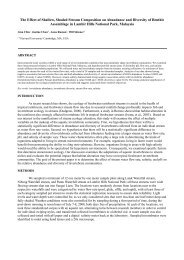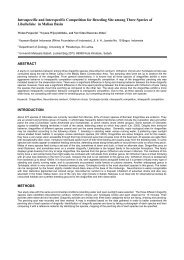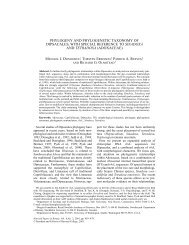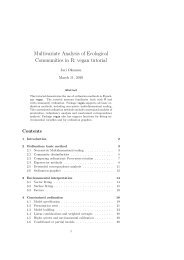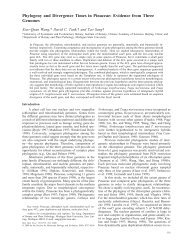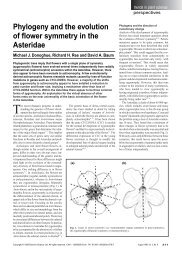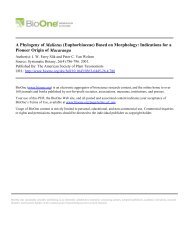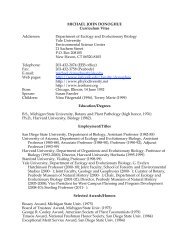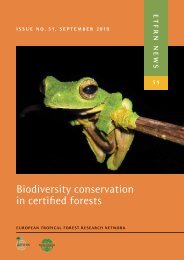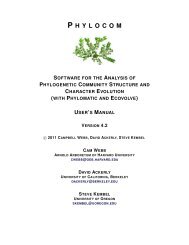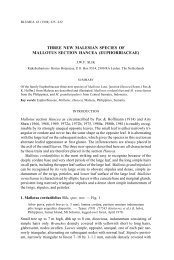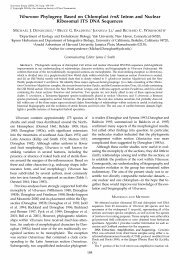The Effect of Bark Type, Canopy Architecture, and Leaf ...
The Effect of Bark Type, Canopy Architecture, and Leaf ...
The Effect of Bark Type, Canopy Architecture, and Leaf ...
You also want an ePaper? Increase the reach of your titles
YUMPU automatically turns print PDFs into web optimized ePapers that Google loves.
<strong>The</strong> <strong>Effect</strong> <strong>of</strong> <strong>Bark</strong> <strong>Type</strong>, <strong>Canopy</strong> <strong>Architecture</strong>, <strong>and</strong> <strong>Leaf</strong> Characteristics on Epiphyte<br />
Abundance <strong>and</strong> Diversity in Maliau Basin Conservation Area, Sabah, Malaysia<br />
Muhamad Ikwan Idris 1 , Gregory A. Parker 2 , <strong>and</strong> Anna M. Ruman 3<br />
1 Department <strong>of</strong> Zoology, Universiti Malaysia Sarawak/ Kota Samarahan, Sarawak, Malaysia<br />
2 Department <strong>of</strong> Environmental Management, Harvard University/ Cambridge, MA, USA<br />
3 Department <strong>of</strong> Organismic <strong>and</strong> Evolutionary Biology, Harvard University/ Cambridge, MA, USA<br />
ABSTRACT<br />
As plants specially adapted to a non-soil substrate, epiphytes face unique challenges to successful growth <strong>and</strong> propagation. <strong>The</strong>se challenges include<br />
balancing light, water, <strong>and</strong> mechanical stability needs, all <strong>of</strong> which are intimately associated with the characteristics <strong>of</strong> the epiphyte's host tree.<br />
<strong>The</strong>refore, we hypothesized that tree leaf type, leaf size, leaf arrangement, bark texture, <strong>and</strong> canopy branch density would have a non-r<strong>and</strong>om<br />
association with the abundance <strong>and</strong> diversity <strong>of</strong> epiphytes associated with a given tree. We surveyed a 300 m transect <strong>of</strong> canopy walkway in Maliau<br />
Basin Conservation Area recorded epiphyte counts <strong>and</strong> identification for 21 trees, <strong>and</strong> recorded the aforementioned characteristics <strong>of</strong> each tree. Using<br />
ANOVA analysis, we found a significant association between bark type <strong>and</strong> epiphyte abundance (Pr (>F)=0.024) <strong>and</strong> epiphyte diversity (Pr<br />
(>F)=.036), with smooth bark hosting the greatest abundance <strong>and</strong> diversity <strong>of</strong> epiphytes. Furthermore, using generalized linear models, we obtained a<br />
significant negative association between canopy branching density <strong>and</strong> epiphyte abundance (Pr(>|z|) = 2e-16) <strong>and</strong> diversity (Pr(>|t|)= 0.000465).<br />
Additional research based upon these highly significant results may indicate precise light, water, <strong>and</strong> mechanical support dem<strong>and</strong>s <strong>of</strong> epiphytes <strong>and</strong><br />
may have the potential to further elucidate the effect on epiphyte abundance <strong>and</strong> diversity due to climate change <strong>and</strong> deforestation.<br />
Key words: epiphyte, bark type, order <strong>of</strong> branching, leaf characteristics, abundance, diversity, Borneo<br />
INTRODUCTION<br />
As mechanically <strong>and</strong> <strong>of</strong>ten nutrient dependent tree-dwellers, epiphytes face distinct challenges to survival<br />
in a non-traditional plant habitat. Epiphyte survival strongly depends on overcoming inavailability <strong>of</strong> light beneath<br />
a thick rainforest canopy, water insecurity <strong>and</strong> inorganic nutrient scarcity in the absence <strong>of</strong> water- <strong>and</strong> nutrientretaining<br />
soil, <strong>and</strong> diminished ability to anchor roots in elevated, non-soil media.<br />
Light availability in an everwet rainforest depends on many factors, including tree height, leaf type<br />
(simple vs. compound), leaf size, <strong>and</strong> leaf arrangement. Epiphyte distribution <strong>and</strong> occurrence is impacted by the<br />
existence <strong>of</strong> a vertical gradient <strong>of</strong> light within the canopy; consequently, epiphytes growing on taller trees<br />
experience greater light incidence. In addition, simple leaves are thought to allow less penetration <strong>of</strong> light than<br />
compound leaves <strong>of</strong> similar size, <strong>and</strong> leaves <strong>of</strong> larger size have also been associated with lower light conditions.<br />
When tree height <strong>and</strong> order <strong>of</strong> branching are st<strong>and</strong>ardized, large leaves exhibit less flutter during wind,<br />
disallowing equivalent passage <strong>of</strong> light as compared to their smaller counterparts (Reyes-Garcia, et al. 2008).<br />
Lastly, leaf arrangement (alternate, opposite, or whorl) may also affect the passage <strong>of</strong> light from the upper canopy<br />
to epiphytes photosynthesizing below, with oppositely-spaced leaves providing maximum light penetration to the<br />
tree's lower branches.<br />
Furthermore, water availability for the epiphyte at any stage <strong>of</strong> development not only depends on local<br />
rainfall <strong>and</strong> humidity, but also upon the bark type <strong>of</strong> the host tree. Seedlings growing on rough, porous, <strong>and</strong>/or<br />
water-retaining bark have greater drought resistance than seedlings growing on smooth bark unable to retain<br />
adequate surface moisture, <strong>and</strong> water scarcity continues as a threat for the mature epiphyte (Reyes-Garcia, et al.<br />
2008). Previous studies have implicated the water-shedding effect <strong>of</strong> smooth bark in decreased drought resistance<br />
<strong>and</strong> consequently decreased moss abundance on smooth-barked trees (Forsyth <strong>and</strong> Miyata, 1984). In contrast,<br />
flaky bark has also been associated with increased water retention <strong>and</strong> consequently increased moss growth (Kim,<br />
et al. 1997).<br />
In addition to its role as a water sink for epiphytes, tree bark also provides the essential substrate to which<br />
epiphyte roots anchor the plant far above the forest floor. Previous studies have shown that trees with rough bark<br />
are conducive to small vines that use tendrils to cling to crevasses (Forsyth <strong>and</strong> Miyata, 1984), but flaky bark<br />
tends to dislodge upon growth <strong>of</strong> heavier epiphytes (Kim, et al. 1997). For the majority <strong>of</strong> epiphytes, the trade-<strong>of</strong>f<br />
between lower mechanical security high among the branches <strong>of</strong> the canopy <strong>and</strong> higher light levels at these riskier<br />
altitudes has been a major factor in epiphyte adaptation.<br />
Lastly, canopy density plays a major role in the distribution <strong>of</strong> epiphytes within the rainforest system. As<br />
previously mentioned, leaf characteristics may play a large role in determining light quantity filtering down from<br />
the upper canopy (Whitmore 1984). However, canopy architecture, or density <strong>of</strong> canopy branching <strong>of</strong> a given tree,<br />
also may impact canopy density measurements.<br />
<strong>The</strong>refore, we hypothesize that tree leaf type with respect to leaf blade (simple versus compound), leaf<br />
size (small, medium, large), leaf arrangement (alternate, opposite, whorl), bark texture, <strong>and</strong> canopy branch density<br />
will have a non-r<strong>and</strong>om association with the abundance <strong>and</strong> diversity <strong>of</strong> epiphytes associated with a given tree.
METHODS<br />
Data collection will occur in an unlogged area <strong>of</strong> Maliau Basin Conservation Area, . We will survey every tree<br />
meeting specifications along a 300 meter transect <strong>of</strong> the rainforest canopy using the Maliau Skybridge, a canopy<br />
walkway ranging from 5-21 meters above ground level. Specifications for surveyed trees include diameter <strong>of</strong> 1.0-<br />
1.5 meters at canopy walkway level as well as absence <strong>of</strong> large lianas due to their interference with epiphyte<br />
growth <strong>and</strong> propagation. For each sample tree, we will estimate leaf size (small leaves, length 20 cm). We will also record leaf structure (simple versus<br />
compound), leaf arrangement (alternate, opposite, or whorl), <strong>and</strong> bark texture (smooth <strong>and</strong> hooped, dippled,<br />
cracked, lenticellate, fissured, flaky, or scaly). A conical section <strong>of</strong> 7 meter radius within each tree's canopy<br />
architecture will be examined using binoculars, <strong>and</strong> the number <strong>and</strong> species <strong>of</strong> present epiphytes will be recorded.<br />
If species level identification proves difficult to attain, particularly for Orchiadaceae sp., family level<br />
identification will be used. Furthermore, we will record order <strong>of</strong> branching (secondary, tertiary, etc.) <strong>and</strong> branch<br />
counts for each sample tree within the 7 meter radius conical section. <strong>The</strong>se values will serve as an indicator <strong>of</strong><br />
complexity <strong>of</strong> canopy architecture. Lastly, we will examine association between epiphyte abundance <strong>and</strong> diversity<br />
<strong>and</strong> leaf size, leaf structure, leaf arrangement, bark texture, <strong>and</strong> canopy architecture using the s<strong>of</strong>tware program R.<br />
Our R analysis will include various ANOVA analyses as well as linear <strong>and</strong> generalized linear models. <strong>The</strong> analysis<br />
<strong>of</strong> variance model tests whether more variation exists within a data set versus between sets <strong>of</strong> data. If more<br />
variation exists between data sets than within, the probability <strong>of</strong> obtaining that variance value (as quantified by<br />
probability <strong>of</strong> obtaining that ANOVA f-statistic) is very low, indicating a non-r<strong>and</strong>om association between two<br />
variables. Furthermore, we will sum counts <strong>of</strong> primary, secondary, tertiary, <strong>and</strong> quaternary branchings within our<br />
sample cone <strong>of</strong> 7 m radius to obtain total branch count per tree. We will compare this total to the total epiphyte<br />
count per tree using linear <strong>and</strong> generalized linear models<br />
RESULTS<br />
TABLE 1: Total Epiphyte Counts <strong>and</strong> Average Number <strong>of</strong> Epiphytes per Tree for Each <strong>Bark</strong> <strong>Type</strong><br />
<strong>Bark</strong><br />
<strong>Type</strong><br />
Number<br />
<strong>of</strong> Trees<br />
Total Epiphyte Counts<br />
Aroid Fern P<strong>and</strong>anus Orchida<br />
ceae<br />
Asplenium<br />
nidus<br />
(Bird's nest<br />
fern)<br />
Platycerium<br />
coronarium<br />
(Stag's horn<br />
fern)<br />
Pyrrosia<br />
piloselloides<br />
Pyrrosia<br />
lanceolata<br />
Total<br />
Count for<br />
all<br />
Epiphyte<br />
Species<br />
Average<br />
Number <strong>of</strong><br />
Epiphytes per<br />
Tree<br />
Cracked 2 1 1 0 1 1 0 6 0 10 5.0<br />
Dippled 2 0 1 0 0 2 0 0 0 3 1.5<br />
Fissured 14 3 13 0 10 5 0 38 1 70 5.0<br />
Smooth &<br />
hooped<br />
Column<br />
Totals<br />
3 4 18 3 4 2 1 9 0 41 13.4<br />
21 8 33 3 15 10 1 53 1 124 N/A<br />
During data collection from the 300 meter transect, we obtained the above data for epiphyte counts for<br />
each <strong>of</strong> four observed tree bark types. We performed an ANOVA analysis to test for non r<strong>and</strong>om association<br />
between total counts <strong>of</strong> each species or family <strong>of</strong> epiphyte with tree bark type. Our ANOVA analysis for epiphyte<br />
abundance <strong>and</strong> bark type indicated a non-r<strong>and</strong>om, statistically significant association, with the probability <strong>of</strong><br />
obtaining a F-statistic as great or greater calculated as 0.024. Next, we calculated a Shannon index to quantify<br />
epiphyte species richness. After renaming the Shannon index matrix, we tested for its non-r<strong>and</strong>om association<br />
with bark type using ANOVA. <strong>The</strong> probability <strong>of</strong> obtaining an F statistic as great or greater was 0.036, indicating<br />
a non-r<strong>and</strong>om association between epiphyte richness <strong>and</strong> tree bark type.<br />
Furthermore, we examined the association between total canopy branch count <strong>and</strong> epiphyte abundance<br />
<strong>and</strong> diversity (see Figure 1). <strong>The</strong> p-value based on a linear model comparing total branch count to epiphyte<br />
abundance was 0.089, indicating that statistical significance at the 5% confidence level could not be claimed for<br />
linear association between branch density <strong>and</strong> epiphyte abundance. Due to the preponderance <strong>of</strong> “0” count values<br />
in our data, a generalized linear model using the Poisson distribution was also used to analyze thisassociation.<br />
Fitting to the Poisson distribution produced a highly significant Pr(>|z|) = 2e-16. This value indicates a very<br />
strong, negative, non-linear association between branch density <strong>and</strong> epiphyte abundance. Lastly, we used a<br />
generalized linear model based on the Gaussian distribution to examine the association between epiphyte species
ichness values <strong>and</strong> total branch counts. This model produced a Pr(>|t|)= 0.000465, indicating a strong negative<br />
correlation between epiphyte species diversity <strong>and</strong> canopy branch density.<br />
Lastly, with reference to other defined variables (leaf size, leaf type, <strong>and</strong> leaf arrangement), we obtained<br />
no significant result for association with either epiphyte abundance or diversity. However, ANOVA analysis <strong>of</strong><br />
association between leaf arrangement <strong>and</strong> epiphyte abundance produced a Pr (>F) = .137, <strong>and</strong> ANOVA analysis <strong>of</strong><br />
association between leaf arrangement <strong>and</strong> epiphyte diversity produced a Pr (>F)= .061, indicating that leaf<br />
arrangement may prove significant in determining epiphyte abundance <strong>and</strong>/or diversity upon use <strong>of</strong> a larger<br />
sample size during further study.<br />
FIGURE 1: Total Epiphyte Count <strong>and</strong> Epiphyte Species Richness Versus Total Branch Count<br />
DISCUSSION<br />
Based on our analysis with the s<strong>of</strong>tware program R, we may conclude that tree leaf size has no<br />
association with epiphyte abundance or diversity. Tree leaf arrangement may have an association with epiphyte<br />
abundance <strong>and</strong>/or diversity, but our sample size for compound leaves was too minimal (1/21 samples) to<br />
determine any relationship. Tree leaf arrangement (alternate, opposite, or whorl) exhibited a weak association with<br />
epiphyte abundance (ANOVA Pr (>F) = 0.137) <strong>and</strong> a moderate association with epiphyte diversity (ANOVA Pr<br />
(>F)= 0.061), but a more conclusive association necessitates further study. In addition, bark texture does exhibit a<br />
highly significant association with both epiphyte abundance <strong>and</strong> diversity as tested through ANOVA analysis.<br />
Smooth bark exhibited the highest abundance <strong>and</strong> diversity <strong>of</strong> epiphytes, followed by cracked <strong>and</strong> fissured, with<br />
dippled bark exhibiting the lowest epiphyte abundance <strong>and</strong> diversity. Lastly, we approximated canopy density<br />
using counts <strong>of</strong> primary, secondary, tertiary, <strong>and</strong> quaternary branches within our 7 m radius sample cone.<br />
Increased branch count exhibited a strong negative correlation with increasing epiphyte abundance <strong>and</strong> a similarly<br />
negative correlation with increasing epiphyte diversity. However, neither <strong>of</strong> the models (Poisson, Gaussian)<br />
utilized to elucidate these associations are linear, suggesting that association between canopy density <strong>and</strong> epiphyte<br />
abundance <strong>and</strong> diversity may tend slightly towards normality.<br />
During sampling, we noted certain methodological difficulties that impacted data collection <strong>and</strong> that<br />
should be addressed during future studies. Our sighting range was limited by the power <strong>of</strong> our binoculars, <strong>and</strong><br />
consequently, we experienced difficulty quantifying number <strong>of</strong> individuals when epiphytes <strong>of</strong> the same species<br />
were clumped. In addition, our data collection serves only as a pilot study to explore the associations between<br />
various factors <strong>and</strong> epiphyte abundance <strong>and</strong> diversity; a large sample size during future studies may further<br />
untangle these complex relationships. Lastly, our data collection technique purposely restricted sampling to the<br />
actual canopy <strong>of</strong> the trees. Although we employed this technique in order to st<strong>and</strong>ardize our sampling area in light<br />
<strong>of</strong> various tree canopy sizes, we only observed abundance <strong>and</strong> diversity <strong>of</strong> canopy-dwelling epiphytes during our<br />
study. Additional studies may sample both in the canopy <strong>and</strong> closer to the rainforest floor to underst<strong>and</strong> the<br />
associations between our study's target factors <strong>and</strong> epiphytes with differing light, water, inorganic nutrient, <strong>and</strong><br />
mechanical support dem<strong>and</strong>s.<br />
<strong>The</strong> results <strong>of</strong> our study have many crucial implications regarding the vulnerability <strong>of</strong> epiphytes to drastic
changes in light or water availability as well as the unique associations between specific epiphyte <strong>and</strong> tree<br />
pairings. <strong>The</strong> significant association between bark type <strong>and</strong> epiphyte abundance <strong>and</strong> diversity as concluded by our<br />
study points to the importance <strong>of</strong> bark water regulation <strong>and</strong> bark-provided mechanical support in determining<br />
epiphyte survival. However, rapidly changing rainfall patterns due to global warming threaten to undermine the<br />
fragile hydraulic relationship between epiphytes <strong>and</strong> host trees. Furthermore, the negative correlation between<br />
canopy density <strong>and</strong> epiphyte abundance <strong>and</strong> diversity indicates an already pressing problem associated with<br />
unsustainable logging. Removal <strong>of</strong> large rainforest trees increases the size <strong>of</strong> gaps, which effectively decreases<br />
canopy density. As a result, epiphytes <strong>and</strong> lianas grow uncontrollably <strong>and</strong> choke the already pulverized rainforest<br />
habitat. Our study's observation <strong>of</strong> this phenomenon in miniature may solidify underst<strong>and</strong>ing <strong>of</strong> its occurrence<br />
even in unlogged forest. Lastly, we recommend further study regarding the most precise model for the association<br />
between canopy branch density <strong>and</strong> epiphyte abundance <strong>and</strong> diversity. Since the strongest association did not<br />
follow a linear model, the data indicates the trade-<strong>of</strong>f between epiphyte ability to anchor in elevated, non-soil<br />
substrate <strong>and</strong> light availability. A non-linear, normally modeled distribution perhaps indicates an “ideal” canopy<br />
branch density for maximum abundance <strong>and</strong> diversity <strong>of</strong> epiphytes, a density at which sufficient light <strong>and</strong><br />
anchoring locations perfect the light versus canopy density trade-<strong>of</strong>f. Further study regarding the balance <strong>of</strong> these<br />
two factors is highly recommended based on our data.<br />
ACKNOWLEDGMENTS<br />
Thank you to...<br />
...Campbell Webb, for his valuable commendation <strong>and</strong> critique regarding the planning <strong>of</strong> our project.<br />
...Min Sheng Khoo, for his humor <strong>and</strong> moral support through the R process.<br />
...Santiago Ramirez, for his dedication <strong>and</strong> patience while assisting us with generalized linear models.<br />
...Shawn Lum, for identifying the elusive <strong>and</strong> mysterious yellow-flowered epiphyte as an orchid.<br />
LITERATURE CITED<br />
Forsyth, A. <strong>and</strong> Miyata, K. (1984). Tropical Nature. Charles Scribner's Sons: New York, NY.<br />
Kim, G. M., Siegel, A. J. And Sh<strong>and</strong>ro, J. R. (1997). Holding on for dear life: <strong>The</strong> effects <strong>of</strong> bark substrate on<br />
epiphyte load <strong>and</strong> composition. Dartmouth Studies in Tropical Ecology. p. 43-50.<br />
Reyes-Garcia, C., Griffiths, H., Rincon, E. <strong>and</strong> Huante, P. (2008). Niche differentiation in tank <strong>and</strong> atmospheric<br />
epiphytic bromeliads <strong>of</strong> a seasonally dry forest. Biotropica 40(2): 168-175.<br />
Whitmore, T. C. (1984). Tropical Rain Forests <strong>of</strong> the Far East. Oxford University Press, New York.



